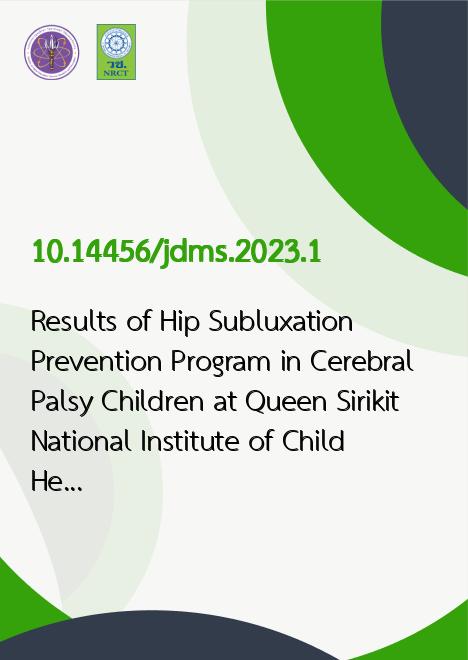
|
Results of Hip Subluxation Prevention Program in Cerebral Palsy Children at Queen Sirikit National Institute of Child Health |
|---|---|
| รหัสดีโอไอ | |
| Creator | Ratcha Lomaneenoparat |
| Title | Results of Hip Subluxation Prevention Program in Cerebral Palsy Children at Queen Sirikit National Institute of Child Health |
| Publisher | สำนักวารสารกรมการแพทย์ |
| Publication Year | 2566 |
| Journal Title | Journal of the Department of Medical Services |
| Journal Vol. | 48 |
| Journal No. | 1 |
| Page no. | 19-Dec |
| Keyword | Cerebral palsy, Hip subluxation, Hip dislocation, Hip dysplasia, Hip surveillance program |
| URL Website | https://he02.tci-thaijo.org/index.php/JDMS |
| Website title | วารสารกรมการแพทย์ |
| ISSN | 2697-6404 |
| Abstract | Background: Hip subluxation is common in children with cerebral palsy, and it can lead to serious complicationssuch as hip pain, limitation of movement, and scoliosis. Hip surveillance programs (early screening and treatment)can reduce the risk of hip dislocation, as well as improve the mobility and quality of life of the CP children. In 2016,QSNICH started the hip surveillance program including preventive and corrective programs. The preventive programcontained early hip x-rays screening, non-surgical treatment, and orthopedic referal as indicated. Objective: Thisstudy aimed to determine the percentage of hip screening before 2 years old and the results of the preventiveprogram to maintain the migration percentage (MP) of less than 40%. Method: Chart reviews of patients visitedwith the first hip x-rays were done from 2015 to 2019. The patients had been followed up for 4 years or until theywere 6 years old. Result: 128 CP children were included during the study period. In 2015, the mean age of patientswho underwent hip screening was 4.83 years old, and 66.67% of the patients had hip x-rays before 2 years old. Afterthe surveillance program was applied, 74.08% of the CP children got the first hip screening before the 2nd year oflife. The average age of hip screening was 3.06 years old. Most of the patients (84.75%) who received the preventiveprogram still had MP below 40% for 1.89 years. Hip posture as 90-degree knee flexion was related to hip migrationprogression. Conclusion: After the implementation of hip surveillance program, the percentage of cerebral palsychildren that had undergone a hip screening before 2 years old was increased. This program prevents hip migrationprogression (MP > 40%) in most patients. |